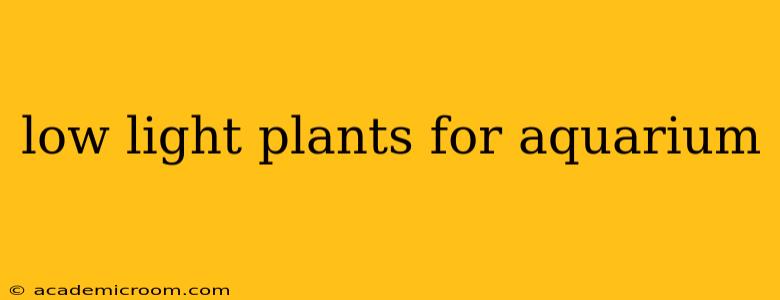Choosing the right plants for your aquarium can significantly impact its overall health and aesthetic appeal. If you're dealing with low-light conditions, whether due to limited natural light or a less powerful aquarium light, don't despair! Many beautiful and hardy plants thrive even with minimal illumination. This guide explores the best low-light aquarium plants, addressing common questions and offering expert tips for success.
What are the best low-light aquarium plants?
Several resilient plants flourish in low-light aquariums. Some top contenders include:
-
Anubias: Known for their durability and adaptability, Anubias varieties (like Anubias Nana and Anubias barteri) tolerate a wide range of conditions, including low light. They're slow-growing, requiring minimal trimming. Attach them to rocks or driftwood to avoid being uprooted.
-
Java Fern: Another incredibly popular choice for beginners, Java Fern (Microsorum pteropus) is exceptionally hardy and thrives in low light. It attaches easily to hardscape and doesn't require planting in the substrate.
-
Java Moss: This versatile plant is perfect for low-light conditions and adds a lush, natural feel to the aquarium. It can be tied to decorations, allowed to grow freely on the substrate, or used as a backdrop.
-
Cryptocoryne: This genus offers a variety of attractive, low-light tolerant plants. Species like Cryptocoryne wendtii and Cryptocoryne parva are particularly well-suited for beginners. They're relatively slow-growing and can handle a range of water parameters.
-
Amazon Sword (Echinodorus bleheri): While ideally preferring moderate light, Amazon Swords can surprisingly adapt to lower light levels. They will grow more slowly, and their leaves might not be as vibrant, but they will survive.
How much light do low-light aquarium plants need?
The term "low light" is relative. Generally, low-light aquarium plants require less than 6 hours of moderate-intensity lighting per day. Over 6-8 hours of even low-intensity lighting could prove excessive, leading to algae problems. Observing your plants closely is crucial; signs of algae overgrowth or pale, leggy growth indicate adjustments are needed (perhaps reducing lighting duration or intensity).
What are some easy-to-care-for low-light aquarium plants?
For those new to the hobby, Anubias, Java Fern, and Java Moss are undoubtedly the easiest options. Their resilience makes them forgiving of minor water parameter fluctuations and occasional lapses in care. They are also slower-growing, requiring less frequent trimming.
Can I use low-light plants in a high-light tank?
While they will survive in high-light conditions, they may not thrive. Low-light plants will grow much slower in brighter environments and may become susceptible to algae competition. Conversely, high-light plants will likely struggle and die if kept in low-light conditions.
Will low-light plants still grow in a completely dark aquarium?
No. Even low-light plants require some light for photosynthesis, the process by which they produce energy. While the amount of light needed is minimal compared to high-light plants, complete darkness will lead to the plant's demise.
How often should I fertilize low-light aquarium plants?
Fertilization is still important, even in low-light tanks. However, the frequency and amount of fertilizer will be less than what high-light plants require. A balanced liquid fertilizer, used sparingly, should suffice. Over-fertilizing can lead to algae blooms, which can harm your plants and the overall tank ecosystem. Always follow the manufacturer's instructions.
What are the signs of unhealthy low-light aquarium plants?
Signs of an unhealthy low-light plant include:
- Pale, translucent leaves: This often indicates insufficient light or nutrient deficiencies.
- Melting leaves: This could be caused by several factors, including poor water quality, bacterial infections, or abrupt changes in water parameters.
- Excessive algae growth: Algae can outcompete your plants for nutrients and light, leading to their decline.
- Slow or stunted growth: This can be a sign of poor light, nutrient deficiencies, or unfavorable water parameters.
By carefully selecting your plants, monitoring your tank's conditions, and providing appropriate care, you can create a thriving and beautiful low-light aquarium. Remember that observation and patience are key to success in any aquatic gardening endeavor.
